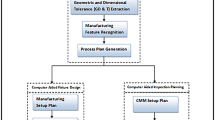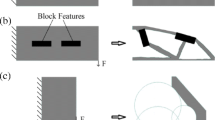Abstract
CAD–CAM integration has involved either design with standard manufacturing features (feature-based design), or interpretation of a solid model based on a set of predetermined feature patterns (automatic feature recognition). Thus existing approaches are limited in application to predefined features, and also disregard the dynamic nature of the process and tool availability in the manufacturing shop floor. To overcome this problem, we develop a process oriented approach to design interpretation, and model the shape producing capabilities of the tools into tool classes. We then interpret the part by matching regions of it with the tool classes directly. In addition, there could be more than one way in which a part can be interpreted, and to obtain an optimal plan, it is necessary for an integrated computer aided process planning system to examine these alternatives. We develop a systematic search algorithm to generate the different interpretations, and a heuristic approach to sequence operations (set-ups/tools) for the features of the interpretations generated. The heuristic operation sequencing algorithm considers features and their manufacturing constraints (precedences) simultaneously, to optimally allocate set-ups and tools for the various features. The modules within the design interpretation and process planner are linked through an abstracted qualitative model of feature interactions. Such an abstract representation is convenient for geometric reasoning tasks associated with planning and design interpretation.
Similar content being viewed by others
References
Allen, J. F. and Koomen, J. A. (1983) Planning using a temporal world model. Proceedings of IJCAI-83, Karlsruhe, West Germany, pp. 741–747.
Arya, S., Cheng, S.-W. and Mount, D. M. (1998) Approximation algorithms for multiple-tool milling. Proceedings of the 14th Annual ACM Symposium on Computational Geometry, Minneapolis, MN, pp. 297–306.
Chakravarty, S. and Shekhawat A. (1992) Parallel and serial heuristics for the minimum set cover problem. Journal of Supercomputing, 5(4), 331–345.
Chang, T.-C. (1990) Expert Process Planning from Manufacturing, Addison Wesley.
Corney, J. and Clark, D. E. R. (1991) Method for finding holes and pockets that connect multiple faces in 2 1/2D objects. Computer Aided Design, 23(10), 658–668.
Cutkosky, M. R. and Tenenbaum, J. M. (1990) A methodology and computational framework for concurrent product and process design. Mechanism and Machine Theory, 25, 365–381.
Dave, P. and Sakurai, H. (1995) Maximal volume decomposition and its application to feature recognition. Proceedings of the AMSE Conference on Computers in Engineering, Minneapolis, MN, pp. 553–568.
De Floriani, L. and Bruzzone, E. (1989) Building a feature-based object description from a boundary model. Computer Aided Design, 21(10), 602–610.
de Kleer, J. (1977) Multiple representations of knowledge in a mechanical problem-solver. Proceedings of the IJCAI, pp. 299–304.
Forbus, K. D. (1988) Qualitative physics: Past, present, and future. Exploring Artificial Intelligence.
Gaines, D. M. and Hayes, C. C. (1999) CUSTOM-CUT: A customizable feature recognizer. Computer Aided Design, 31(2), 85–100.
Gaines, D. M., Castaño, F. and Hayes, C. C. (1996) Achieving reconfigurable CAD/CAPP integration by reasoning from shape producing capabilities. Proceedings of Artificial Intelligence and Manufacturing Research Planning Workshop, AAAI Press, Albuquerque, NM, pp. 53–62.
Gavankar, P. and Henderson, M. R. (1990) Graph-based extraction of protrusions and depressions from boundary models of three-dimensional objects. Computer Aided Design, 22(7), 442–450.
Gupta, S. K. (1994) Automated Manufacturability Analysis of Machined Parts, Ph.D. thesis, University of Maryland, College Park.
Halevi, G. and Weill, R. (1995) Principles of Process Planning: A Logical Approach. Chapman & Hall.
Han, J., Pratt, M. and Regli, W. C. (2000) Manufacturing feature recognition from solid models: A status report. IEEE Transactions on Robotics and Automation, 16(6), 782–796.
Hayes, C. and Wright, P. (1989) Automating process planning: Using feature interactions to guide search. Journal of Manufacturing Systems, 8(1), 1–15.
Ji, Q. and Marefat, M. (2003) Machine interpretation of CAD data for manufacturing applications. ACM Computing Surveys, 29(3), 1997.
Johnson, D. S. (1974) Approximation algorithms for combinatorial problems. Journal of Computer and System Sciences, 9, 256–278.
Johnson, E. J. (1996) Systematic spatial inferencing using a qualitative model for manufactured components, Master's thesis, Department of Electrical and Computer Engineering, University of Arizona.
Johnson, E. J. and Marefat, M. M. (1997) A model and inferencing mechanism for spatial reasoning with manufactured components. IEEE International Conference on Robotics and Automation, Albuquerque, New Mexico.
Joshi, S. and Chang, T. C. (1988) Graph-based heuristics for recognition of machined features from a 3D solid model. Computer Aided Design, 20(2), 58–66.
Kambhampati, S. and Cutkosky, M. (1990) An approach toward incremental and interactive planning for concurrent product and process design. Issues in Design/Manufacture Integration, 29, 1–8.
Karinthi, R., Nau, D. and Yang, Q. (1992) Handling feature interactions in process planning. Applied Artificial Intelligence, 6, 389–415.
Kim, Y. S. (1992) Recognition of form features using convex decomposition. Computer Aided Design, 24(9), 461–476.
Kramer, T. R. (1992) A library of material removal shape element volumes (MRSEVs). Technical NISTIR 4809, The National Institute of Standards and Technology, Gaithersburg, MD.
Lee, S. H., Cutkosky, M. R. and Kambhampati, S. (1991) Incremental and interactive geometric reasoning for fixture and process planning. Issues in Design/Manufacture Integration, 39, 7–13.
Mahanti, A., Karinthi, R., Ghosh, S. and Pal, A. (1991) AI search for minimum-cost set cover and multiple-goal plan optimization problems: applications to manufacturing, planning and scheduling. The Fourth International Conference on Industrial and Engineering Applications of AI and Expert Systems, pp. 666–675.
Marefat, M. and Britanik, J. (1994) Case-based process planning. Proceedings of the NSF Design and Manufacturing Systems Conference, Cambridge, MA.
Marefat, M. and Kashyap, R. L. (1990) Geometric reasoning for recognition of three-dimensional object features. IEEE Transactions on Pattern Analysis and Machine Intelligence, 12(10), 949–965.
Mukerjee, A. and Joe, G. (1990) A qualitative model for space. Proceedings of the Eighth National Conference on Artificial Intelligence (AAAI), pp. 721–727.
Nau, D., Gupta, S. K., Kramer, T. R., Regli, W. C. and Zhang, G. (1993) Development of machining alternatives based on MRSEVs. Proceedings of the AMSE Conference on Computers in Engineering, San Diego, CA, pp. 47–57.
Nilsson, N. J. (1980) Principles of Artificial Intelligence, Morgan Kaufmann Publishers, Inc.
Ostwald, P. F. (1988) AM Cost Estimator, McGraw-Hill.
Raman, R. (2001) Integrated Process Planning with Qualitative Shape Descriptions and Tool/Process Capability Models, Master's thesis, Department of Aerospace and Mechanical Engineering, University of Arizona, AZ.
Raman, R. and Marefat, M. M. (2001a) Automating Process Planning Through Qualitative Spatial Inferencing and Tool Capability Matching. Technical report, University of Arizona, Tucson, AZ.
Raman, R. and Marefat, M. M. (2001b) Integrating Process Planning with Design Interpretation. Technical report TR-ISL-22, University of Arizona, Tucson, AZ.
Rho, H. M., Geelink, R., van't Erve, A. H. and Kals, H. J. J. (1992) An integrated cutting tool selection and operation sequencing method. Annals of CIRP, 41, 517–520.
Sakurai, H. (1994) Decomposing a delta volume into maximal convex volumes and sequencing them for machining. Proceedings of the AMSE Conference on Computers in Engineering, pp. 135–142.
Sakurai, H. (1995) Volume decomposition and feature recognition: Part 1 polyhedral objects. Computer Aided Design, 27(11), 833–843.
Sapiecha, P. (1993) A novel approach to the minimal cover problem. Proceedings of the International Workshop on Rough Sets and Knowledge Discovery, pp. 237–241.
Sarma, S. E. (1995) A Methodology for Integrating CAD and CAM in Milling, Ph.D. thesis, University of California, Berkeley, CA.
Shah, J. J. and Mäntylä, M. (1995) Parametric and Feature-Based CAD/CAM, John Wiley & Sons, Inc.
Shah, J. J., Shen, Y. and Shirur, A. (1994) Determination of machining volumes from extensible sets of design features, in Advances in Feature Based Manufacturing, Shah, J. J., Mäntylä, M. and Nau, D. S. (eds), Elsevier Science.
Srikantappa, A. B. and Crawford, R. H. (1992) Intermediate geometric and interfeature relationships for automatic group technology part coding. Proceedings of the AMSE Conference on Computers in Engineering, Vol. 1, pp. 245–251.
Stage, R., Roberts, C. and Henderson, M. (1999) Generating resource based flexible form manufacturing features through objective driven clustering. Computer Aided Design, 31(2), 119–130.
Tseng, Y.-J. and Joshi, S. B. (1994) Recognizing multiple interpretations of interacting machining features. Computer Aided Design, 26(9), 667–688.
Vandenbrande, J. H. and Requicha, A. A. G. (1990) Spatial reasoning for automatic recognition of interacting form features. Proceedings of the AMSE Conference on Computers in Engineering, pp. 251–256.
Vandenbrande, J. H. and Requicha, A. A. G. (1993) Spatial reasoning for the automatic recognition of machinable features in solid models. IEEE Transactions on Pattern Analysis and Machine Intelligence, 15(12), 1269–1285.
Yut, G. and Chang, T. C. (1995) A heuristic grouping algorithm for fixture and tool setups. Engineering Design and Automation, 1(1), 21–31.
Zhang, H.-C. and Alting, L. (1994) Computerized Manufacturing Process Planning Systems, Chapman & Hall.
Author information
Authors and Affiliations
Rights and permissions
About this article
Cite this article
Raman, R., Marefat, M.M. Integrated process planning using tool/process capabilities and heuristic search. Journal of Intelligent Manufacturing 15, 141–174 (2004). https://doi.org/10.1023/B:JIMS.0000018030.40309.e0
Issue Date:
DOI: https://doi.org/10.1023/B:JIMS.0000018030.40309.e0




